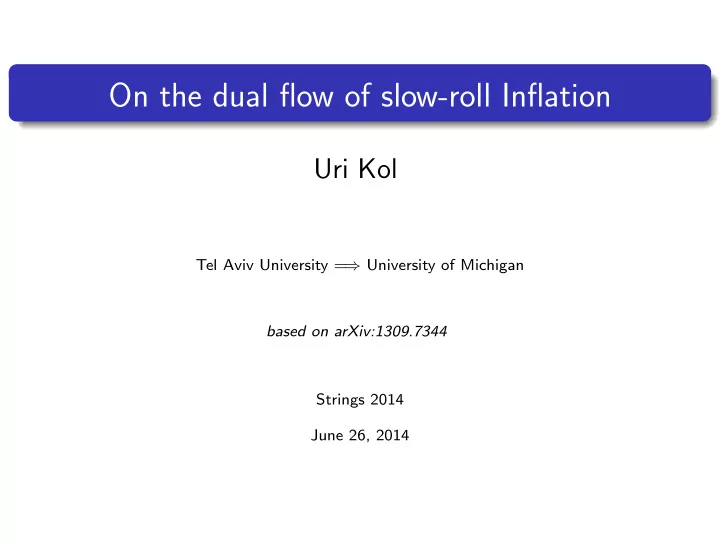

On the dual flow of slow-roll Inflation Uri Kol Tel Aviv University = ⇒ University of Michigan based on arXiv:1309.7344 Strings 2014 June 26, 2014
Slow-roll Inflation and the dS/CFT correspondence The inflationary background interpolates between two de Sitter phases with different Hubble radii. The famous calculation of the power spectrum of fluctuations is an approximation in the Quasi de Sitter region, which gives the Slow-roll corrections to the leading scale-invariant spectrum. 1 P ( k ) ∼ k d +2 ǫ + η ✂✂ ✍ ❪ ❏ ❏ Scale-invariant Slow-roll corrections The dS/CFT correspondence suggests a duality between a gravitational theory in de Sitter spacetime and a CFT living on a constant time slice at temporal infinity. The dictionary is Z [ g ] = Ψ [ g ] ∼ e iS cl The central charge of each fixed point is related to the corresponding Hubble constant 1 a ∼ H d − 1 The dual process to slow-roll Inflation is then interpreted as an RG flow between two fixed points. 1 / 8
Goals and Strategy The goal: Calculate correlation functions in the dual field theory beyond the Quasi de Sitter approximation �OO� dictionary The challenge: b.c. The dictionary relates the behavior of bulk fields near the boundary (late times) to the dual field theory while the Bunch-Davies boundary conditions are imposed at early times. The strategy: Find a solution in the bulk that interpolates between early and late times using a matching procedure. Byproduct: The solution at all times can also be used to study bulk properties (Inflation). 2 / 8
The matching procedure The matching is between two different solutions which are separately valid at different regions of the space of parameters but together cover all of it: Perturbative solution . The perturbative solution expansion parameter is the momentum over the inverse comoving Hubble radius k A ′ Solution in the Quasi de Sitter region. For sufficiently low momentum the perturbative solution will be valid all the way to the Quasi de Sitter region and we can match the two solutions. 3 / 8
The results The comoving curvature perturbation ζ has two solutions: ζ ( t ) ≃ D 0 + D 1 e − dHt The Bunch-Davies boundary conditions at early times fix the Quasi de Sitter wave function D ( QdS ) ∼ k − d +(2 ǫ + η ) D ( QdS ) 1 ≡ G ( k ) ∼ k d +(2 ǫ + η ) , 2 0 D ( QdS ) 0 The matching procedure transfers the information about the boundary conditions in the IR to the late time solution and the result is a mixing between the amplitudes: Potential Wall � D 0 � � D 0 � � � 1 c 2 ( k ) ∼ k 2 c 1 ( k ) D 1 1 D 1 QdS late This result is expected since this problem is similar to solving the Schr¨ odinger equation with a potential wall, where the modes in one side of the wall are superposition of the modes on the other side. 4 / 8
Explicit breaking phase In the explicit breaking phase �OO� ∼ G ( k ) ∼ k d +2 ǫ + η + . . . where ” . . . ” corresponds to subleading and local terms. This spectrum corresponds to a perturbation of the IR fixed point by a quasi-marginal operator of dimension ∆ IR = d + 2 ǫ + η 2 In particular, the mixing coefficients appear only at subleading orders. 5 / 8
Spontaneous breaking phase In the spontaneous breaking phase we find �OO� ∼ 1 − c 2 ( k ) G ( k ) 1 1 1 1 G ( k ) − k 2 c 1 ( k ) ∼ k 2 + · · · + k 2∆ IR − d + . . . ∼ k 2 + . . . c 1 (0) c 1 (0) 1 The leading term at low momentum is a massless pole with a residue c 1 (0) . The field theory interpretation - a dilaton interacting with a perturbed CFT. Schematically, the Lagrangian is of the form L = 1 2 ( ∂τ ) 2 + L IR + gτ O IR We have to sum over all the following diagrams with arbitrary number of intermediate O IR states. The result is 1 � ττ � ∼ k 2 − g 2 �O IR O IR � 6 / 8
Example: Exact solution in (2 + 1) -dimensions In (2 + 1) -dimensions we where able to calculate the residue exactly c 1 (0) ∼ H − 1 UV − H − 1 IR which leads to the following two-point function 1 1 �OO� ∼ H − 1 UV − H − 1 k 2 IR In agreement with the expectation from the dilaton effective action d 2 x √− g S dilaton = ∆ c � τR + ( ∂τ ) 2 � � 24 π which gives in flat space 1 1 � ττ � ∼ k 2 ∆ c (recall that in 2D c ∼ H − 1 ). 7 / 8
Future directions Calculate more mixing coefficients (beyond 2D). The effect of the mixing on cosmological observables in the bulk, like the bispectrum (the three-point function). Relate the mixing coefficients, in a systematic way, to the parameters of the flow (running couplings or terms in the dilaton effective action). Applications to mathematics - the mixing coefficients are related to the solutions of the Heun equation, which has many applications in physics. 8 / 8
Recommend
More recommend